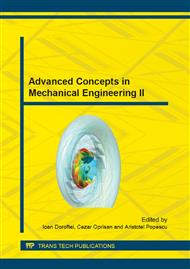p.101
p.107
p.112
p.118
p.127
p.133
p.139
p.145
p.151
Simulating the Torque and Angular Speed Distribution within a Heavy Vehicle’s Planetary Gearbox
Abstract:
Simulating the real-time working of a system a complex challenge that had been developed lately within almost all fields of activity, of course including mechanical engineering as well. If one wants to reveal the torque and angular speed distribution onto the elements of a planetary gearbox, issuing a virtual model was previously needed. This model should replicate both the physical structure and the real working behavior.The modeled and simulated gearbox is a planetary type one. The power flows along the gearbox throughout three simple planetary mechanisms (sun gear and crown type) by successively locking different components with the aid of some multi-plate clutches (acting as locking clutches or brakes). The simulation of the friction element’s engagement is achieved by introducing a physical signal that replaces the pressure of the hydraulic command system. We mention that the pressure evolution has been previously experimentally determined, in order to model the force that acts on the actuator’s piston that, at its turn, presses the plates.The paper reveals the working cycles of the friction elements as well as the working modes of the planetary sets. It also reveals the time histories of the power flowing throughout the gearbox. The friction elements are modeled considering their three working stages: fully disengaged, partially engaged and fully engaged. The planetary sets are modeled starting from Willis equation for the speed distribution. For the torque distribution we used the energy conservation law as well as the torque balance law.Should be also mentioned that the virtual simulating model took into account the effects of the twisting vibrations, spinning inertia of the mechanical components and shafts’ elasticity.
Info:
Periodical:
Pages:
127-132
Citation:
Online since:
October 2014
Keywords:
Price:
Сopyright:
© 2014 Trans Tech Publications Ltd. All Rights Reserved
Share:
Citation:


